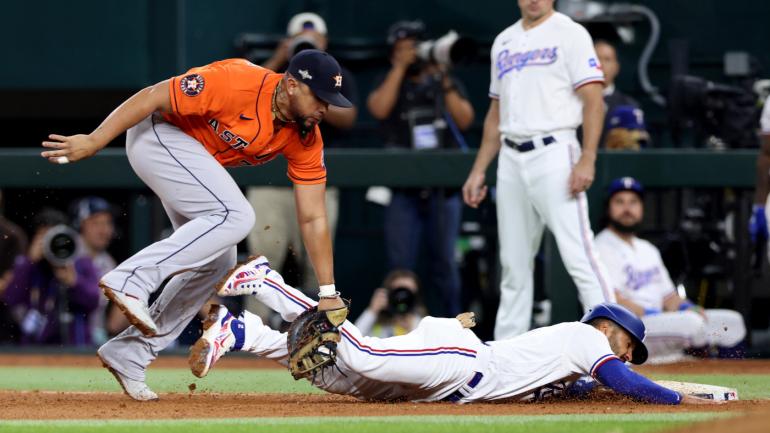
During the bottom of the fifth inning in ALCS Game 4, the Texas Rangers were trailing the Houston Astros, 7-3, but had a bit of a rally going. Leody Taveras and Marcus Semien singled to start the inning, bringing superstar shortstop Corey Seager to the plate. Seager, who had homered in his previous at-bat, lined out this time. And it ended up being a double play, after replay review overturned the initial call of safe at first base when Semien slid back to first base in an attempt to avoid the tag from José Abreu.
Abreu did tag Semien. Sort of. It seems pretty clear that he got the batting glove hanging out of Semien’s back pocket and that’s it. Watch:
We’ve seen players awarded first base when only their jersey is hit by a pitch, but we also know that on review, MLB has clarified that the strings hanging off a defender’s glove don’t count and the actual glove needs to touch the player for it to be a successful tag. Where does a batting glove hanging out of a pocket fall?
Apparently, it counts as tagging the runner. Otherwise the call wouldn’t have been overturned.
“You want to get back on a liner,” Semien said after the game. “I was caught leaning a little bit, tried to get back. Just bad luck.”
Here are two definitions from the official MLB rulebook that come closest to guiding us to an answer on this one.
A TAG is the action of a fielder in touching a base with his body while holding the ball securely and firmly in his hand or glove; or touching a runner with the ball, or with his hand or glove holding the ball (not including hanging laces alone), while holding the ball securely and firmly in his hand or glove. It is not a tag, however, if simultaneously or immediately following his touching a base or touching a runner, the fielder drops the ball. In establishing the validity of the tag, the fielder shall hold the ball long enough to prove that he has complete control of the ball. If the fielder has made a tag and drops the ball while in the act of making a throw following the tag, the tag shall be adjudged to have been made. For purposes of this definition any jewelry being worn by a player (e.g., necklaces, bracelets, etc.) shall not constitute a part of the player’s body.
TOUCH. To touch a player or umpire is to touch any part of his body, or any uniform or equipment worn by him (but not any jewelry (e.g., necklaces, bracelets, etc.) worn by a player). (Touch) Comment: Equipment shall be considered worn by a player or umpire if it is in contact with its intended place on his person.
Notice the parenthetical specifying the laces on the glove don’t count. That addition was made in 2016 due to some replay overturns that proved controversial. We can see that jewelry doesn’t count, but a batting glove isn’t jewelry. It also isn’t his uniform. It is equipment, but when it’s in his pocket, it isn’t being worn.
Here’s where it gets tricky and MLB probably needs to clarify: Take note of that last comment in the “touch” section. Specifically: Equipment shall be considered worn by a player or umpire if it is in contact with its intended place on his person.
That was a batting glove and the intended place on a player’s person is his hands. If not on his hands, isn’t a batting glove not being worn? I guess the argument against this would be that Semien intended to put the batting gloves in his back pocket, so they are technically being worn?
We’ll surely get word from Major League Baseball on this one, and while it might seem insignificant, you can bet there will be fallout. Players won’t be so liberal with batting gloves hanging out of their pockets anymore in big spots, you can be sure of that.